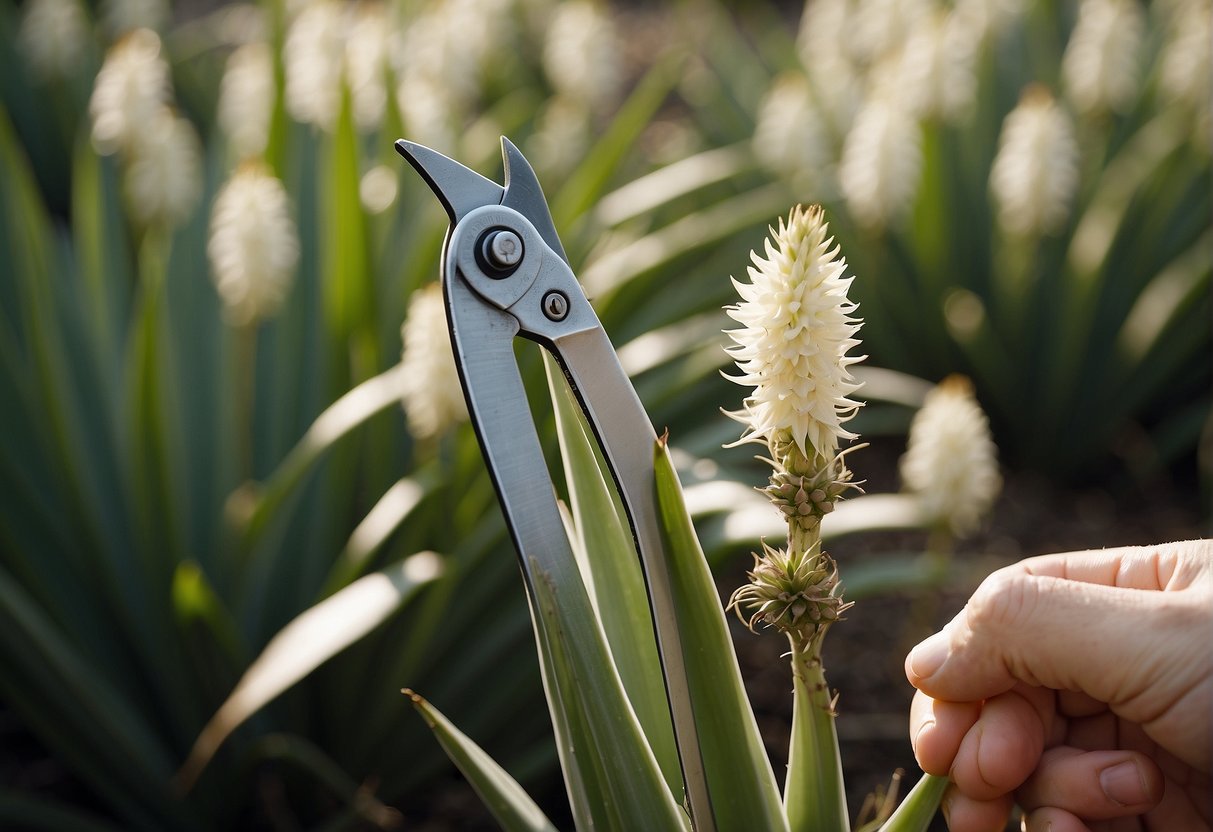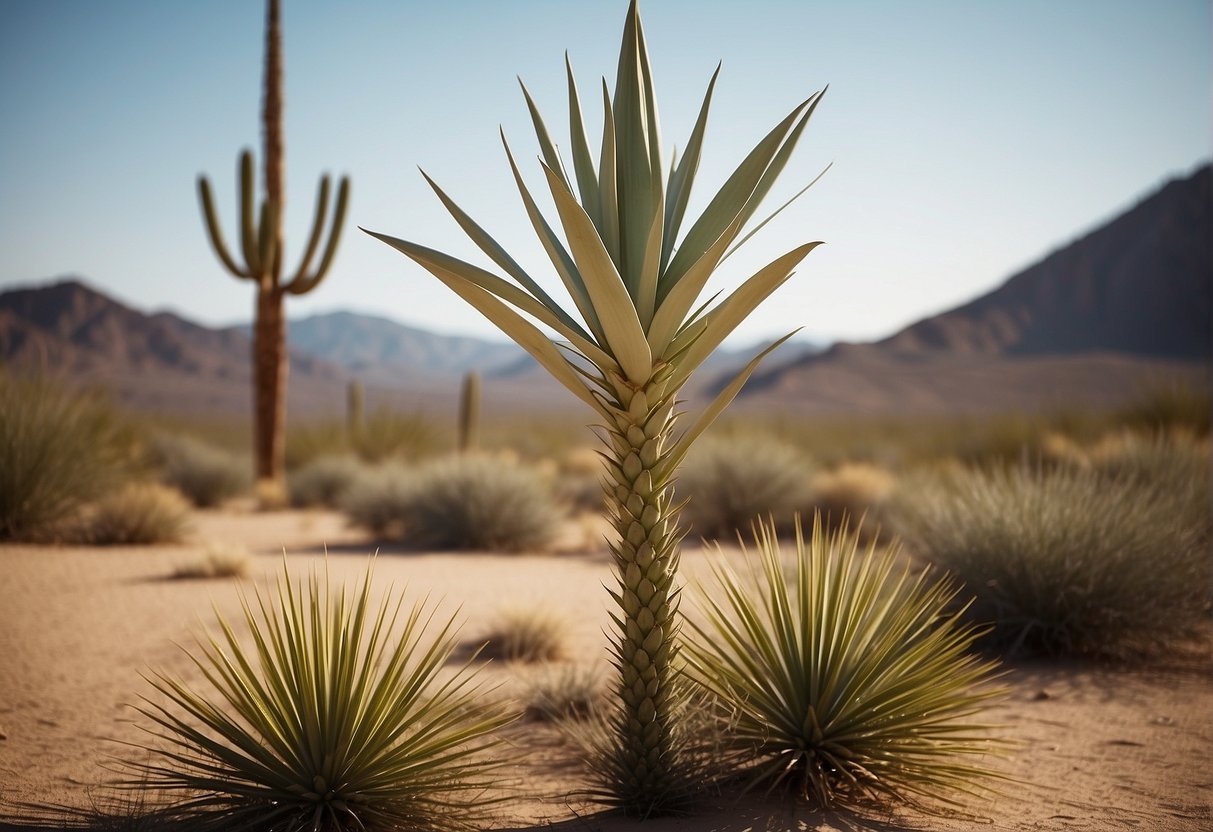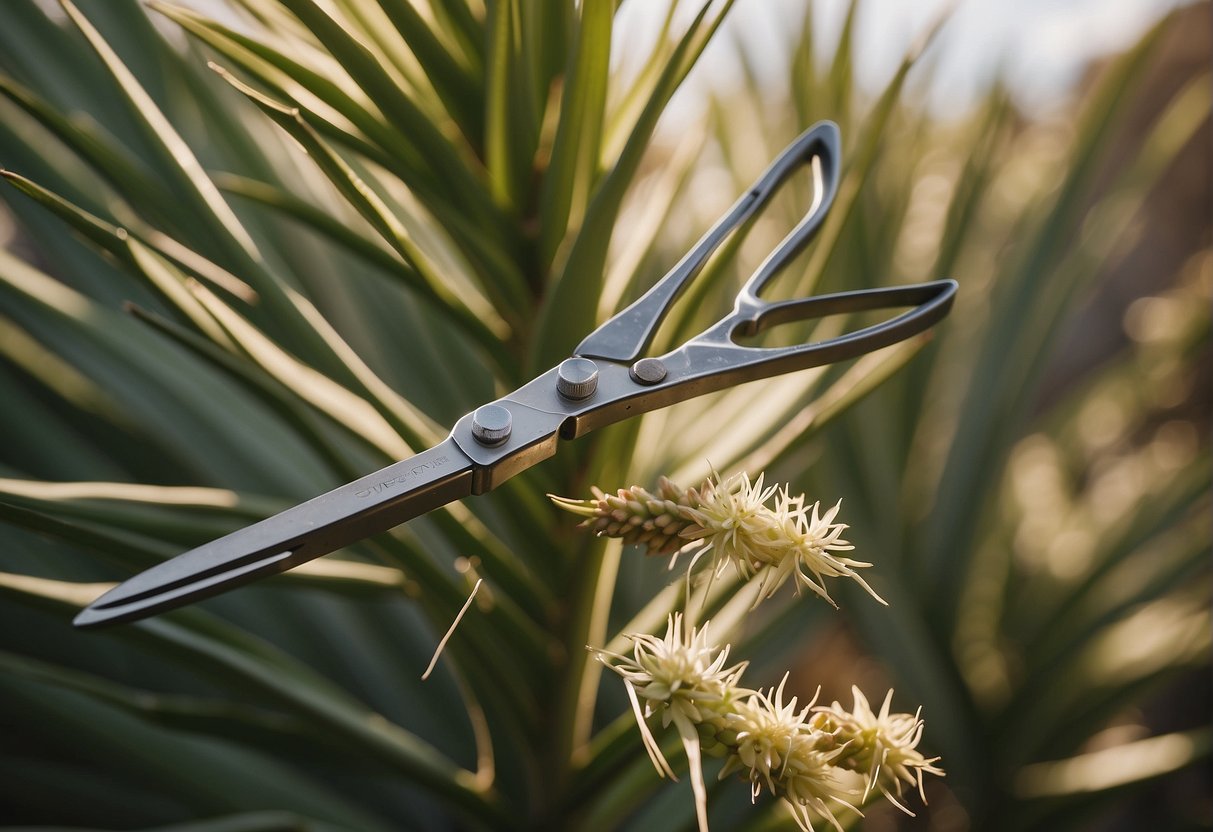When to Cut the Flower Stalk on Yucca Plants
Regarding the care of your yucca plant, trimming the flower stalk is a key measure that shouldn’t be ignored. Identifying the appropriate moment to trim the flower stalk is vital for the well-being and development of your yucca. In this guide, we’ll explore the best time for pruning the yucca flower stalk, along with the necessary care and upkeep following the trim.

Understanding Yucca Plant Growth
Yucca plants are known for their long, sword-shaped leaves and tall, spiky flower stalks. These plants typically bloom in the late spring or early summer and can continue to flower for several weeks. However, once the flowers have wilted and died, it is important to remove the flower stalk to encourage new growth.
Optimal Conditions for Yucca Flowering
To ensure that your yucca plant blooms at its fullest potential, it is important to provide it with optimal growing conditions. Yucca plants thrive in well-draining soil and require plenty of sunlight. They are also drought-tolerant and do not require frequent watering. By providing your yucca plant with these optimal conditions, you can ensure that it produces a healthy flower stalk that will require minimal pruning.
Key Takeaways
- Pruning the flower stalk on your yucca plant is important for its growth and health.
- Yucca plants require optimal growing conditions such as well-draining soil and plenty of sunlight to produce a healthy flower stalk.
- Once the flowers have wilted and died, it is important to remove the flower stalk to encourage new growth.
Understanding Yucca Plant Growth

Yucca plants are known for their striking flower spires, which can add a dramatic touch to any garden or landscape. To ensure that your yucca plant produces the best possible blooms, it’s important to understand its growth habits and flowering cycles.
Growth Stages and Bloom Cycles
Yucca plants typically take several years to mature and produce flowers. During the first few years of growth, the plant will focus on establishing a strong root system and developing its foliage. Once the plant reaches maturity, it will begin to produce a flower stalk.
The bloom cycle of a yucca plant can vary depending on the species and growing conditions. Some yucca plants will produce flowers every year, while others will only bloom every few years. The bloom cycle can also be affected by environmental factors such as temperature and humidity.
Species-Specific Flowering Habits
Different species of yucca plants have different flowering habits. Some species, such as the Yucca filamentosa, will produce flowers in the summer, while others, such as the Yucca gloriosa, will bloom in the spring. Some yucca plants will produce a single flower spike, while others will produce multiple spikes.
It’s important to research the specific species of yucca plant that you have in order to understand its unique growth and flowering habits. This will help you determine the best time to cut the flower stalk and ensure that your plant continues to produce healthy blooms year after year.
Overall, understanding the growth habits and flowering cycles of your yucca plant is key to ensuring its long-term health and beauty. By taking the time to research your plant’s specific needs and following best practices for pruning and care, you can enjoy vibrant, healthy blooms for years to come.
Optimal Conditions for Yucca Flowering
When it comes to yucca plants, flowering is a highly anticipated event. The flower stalks can reach up to several feet tall and are covered in beautiful, bell-shaped blooms. However, to ensure your yucca plant produces the best flowers possible, it’s important to provide the optimal conditions for flowering.
Soil and Water Requirements
Yucca plants thrive in well-draining soil, so it’s important to make sure the soil is not too compacted or waterlogged. A good rule of thumb is to water deeply but infrequently, allowing the soil to dry out slightly between waterings. Overwatering can lead to root rot and other issues that can hinder flowering.
Sunlight and Temperature Needs
Yucca plants require full sun to thrive and produce the best flowers. Make sure your yucca plant is placed in an area that receives at least 6 hours of direct sunlight per day. Additionally, yucca plants prefer warm temperatures and are best suited for USDA hardiness zones 6-11.
It’s also important to note that yucca plants typically flower in early summer, so providing the optimal conditions during this time is crucial for successful flowering.
By following these guidelines for soil, water, sunlight, and temperature, you can ensure that your yucca plant produces the best flowers possible.
Pruning Yucca Flower Stalks

If you have yucca plants in your garden, you know that they produce tall, showy flower stalks that can add beauty and interest to your landscape. However, these stalks can also become unsightly or even hazardous if they start to droop or become top-heavy. In this section, we’ll cover when and how to prune yucca flower stalks, as well as the tools and techniques you’ll need to do it safely.
When and How to Prune
The best time to prune yucca flower stalks is in the late spring or early summer, once the flowers have started to fade and the stalks have begun to dry out. This is the time when the plants are entering their dormant period, so pruning won’t interfere with their growth or blooming cycle.
To prune a yucca flower stalk, start by assessing its height and condition. If the stalk is still upright and sturdy, you may want to leave it in place for a while longer to enjoy its beauty. However, if the stalk is drooping or leaning, or if it has become top-heavy and is in danger of falling over, it’s time to remove it.
To remove a yucca flower stalk, use a pair of sharp pruning shears or pruners to cut the stalk as close to the base of the plant as possible. Be sure to wear gloves to protect your hands from the sharp leaves and spines of the yucca plant.
Tools and Techniques for Safe Pruning
When pruning yucca flower stalks, it’s important to use the right tools and techniques to ensure that you do it safely and effectively. Here are some tips to keep in mind:
- Use sharp pruning shears or pruners to make clean cuts and avoid damaging the plant.
- Wear gloves to protect your hands from the sharp leaves and spines of the yucca plant.
- Cut the stalk as close to the base of the plant as possible to avoid leaving a stub that could attract pests or disease.
- Dispose of the cut stalk properly, either by composting it or placing it in the trash.
By following these tips, you can safely and effectively prune your yucca plants to keep them healthy and looking their best.
Post-Pruning Care and Maintenance
After pruning the flower stalk on your yucca plant, it’s important to take care of the plant to promote healthy regrowth and prevent pests and disease. Here are some tips to help you take care of your yucca plant after pruning:
Promoting Healthy Regrowth
To promote healthy regrowth, make sure your yucca plant is getting enough sunlight and water. Yucca plants need full sun to grow properly, so make sure they are getting at least 6 hours of direct sunlight each day. Water your yucca plant deeply once a week, but make sure the soil drains well to prevent root rot.
You can also fertilize your yucca plant with a balanced fertilizer to promote healthy growth. Use a fertilizer with equal parts nitrogen, phosphorus, and potassium, and apply it once a month during the growing season.
Preventing Pests and Disease
Yucca plants are generally resistant to pests and disease, but they can still be affected by insects like aphids, mealybugs, and scale. To prevent these pests from attacking your yucca plant, keep the plant clean and free of debris. You can also spray the plant with insecticidal soap to kill any pests that are present.
If your yucca plant does get infected with a disease, such as root rot or leaf spot, remove the infected parts of the plant immediately to prevent the disease from spreading. You can also treat the plant with a fungicide to help control the disease.
By following these tips, you can help your yucca plant recover from pruning and grow healthy and strong.
Frequently Asked Questions
How should I prune my outdoor yucca plant after it blooms?
After your yucca plant finishes blooming, you can prune it by cutting off the flowering stalk. This will help to keep the plant looking neat and tidy. You can also remove any dead or damaged leaves from the plant to promote new growth.
What is the proper technique for cutting a yucca’s flower spike?
To cut a yucca’s flower spike, you should use a sharp, clean pair of pruning shears. Cut the stalk at the base, as close to the main stem as possible. Be sure to wear gloves and protective clothing, as the leaves can be sharp and prickly.
Can cutting the top off a yucca plant affect its future growth?
Cutting the top off a yucca plant can affect its future growth, as it can cause the plant to grow multiple stems instead of one central trunk. If you want to maintain the plant’s natural shape, it’s best to avoid cutting the top off.
Is it necessary to remove the flower stalk from my yucca?
It’s not necessary to remove the flower stalk from your yucca plant, but doing so can help to keep the plant looking tidy. If you choose not to remove the stalk, it will eventually dry up and fall off on its own.
When is the best time to trim a yucca plant’s trunk?
The best time to trim a yucca plant’s trunk is in the spring or summer, when the plant is actively growing. Avoid trimming the trunk in the fall or winter, as this can leave the plant vulnerable to cold damage.
How can I manage the height of my yucca without damaging it?
To manage the height of your yucca plant without damaging it, you can prune the top of the plant and remove any dead or damaged leaves. You can also transplant the plant to a larger container or a location with more space, which will allow it to grow taller without becoming crowded.


